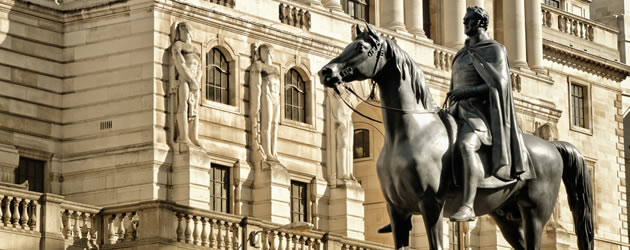The Pound Sterling to Euro (GBP/EUR) exchange rate remained in a tight range on Thursday despite both favourable German and UK data, while the Pound Sterling to US Dollar (GBP/USD) and Pound Sterling to Canadian Dollar (GBP/CAD) exchange rates both fell on oil prices and as favourable US data spurred speculation that the Federal Reserve may begin to hike interest rates.
Last year, the Pound had been in the US Dollar’s position, top dog in the market supported by fantastic data and a hawkish central bank, the Bank of England (BoE).
However, the well woven hypotheses for a November 2014 rate hike began to unravel when the data slowed and the central bank became unreliable—and unreliable is the opportune word here.
BoE Governor Mark Carney earned himself the reputation of an ‘unreliable boyfriend’ after suggesting rate hikes were on the way and then changing his mind, not once but several times.
Carney lost his sway with investors as the banker who cried wolf caused massive Sterling fluctuations ahead of a November rate hike that never came.
Okay, so maybe January 2015 then?
The BoE was then expected to begin hiking interest rates in the first part of 2015. It seemed as if we were geared up for it, the data was still reasonably good, members of the Monetary Policy Committee (MPC) were still disagreeing on whether to increase borrowing costs or not toward the end of 2014; surely we were on the way to moving the bank rate away from 0.5%?
Wrong again. Global inflation began to drop and economists suggested that it may prevent the central bank from hiking interest rates.
BoE Governor Mark Carney rebuffed this argument, suggesting that the central bank would look through low inflation and hike rates anyway.
Carney stated: ‘What this means though [low inflation], for this economy to have balance and inflation to get back to two percent over the next few years, is that… interest rates are going to have to increase.’
But that hasn’t exactly been the case… because where are we now?
So far, 2015 has seen the entirety of the MPC decide that keeping rates stable in the near future is appropriate, BoE chief economist Andrew Haldane stating that a rate cut could occur in the near future and BoE Governor Mark Carney take a hawkish tone earlier in the year and then revert back to dovishness.
US Dollar Exchange Rate (USD) Rallies on Federal Reserve Rate Hike Bets
The US Dollar is currently in the same position as the Pound Sterling once was; investor sentiment in the ‘Greenback’ rallies on favourable data while policymakers dispute the issue of borrowing costs. Some officials are urging the central bank to hike rates immediately while others remain more cautious—and perhaps most importantly, investor sentiment causes frequent rallies.
The Federal Reserve has been much calmer in translating its meetings to the general public. Carney was much like an excited school child, suggesting Christmas could come early, whereas Fed Chair Janet Yellen has remained the grown up, stating that the time will come when the time comes.
However, investor sentiment got another boost on Thursday when US Initial Jobless Claims came in far lower than the 302K forecast in the week though 21st March. Instead, the actual recording reached only 282K. Continuing Jobless Claims also beat predictions when they fell below the estimated 2425K to 2416K in the week through 14th March.
And the good news didn’t stop there; Markit’s US Services Purchasing Managers Index (PMI) was forecast to fall from 57.1 to 55.7 but instead jumped to 58.6. As a result, the Composite measure climbed from 57.2 to 58.5.
The data, combined with Federal Reserve official Dennis Lockhart’s statements on interest rate hikes in the middle of 2015, caused the US Dollar to jump.
And where does the European Central Bank (ECB) stand in all this? The ECB has been headed in the complete opposite direction when it comes to monetary policy, loosening conditions while the Fed and BoE look to tighten them.
The ECB recently began a period of quantitative easing (QE) in an attempt to encourage growth in the 19-nation area.
Thursday saw ECB President Mario Draghi speak and suggest that the much-feared bond shortage seems to have been an uncalled for concern.
Meanwhile, the Canadian Dollar enjoyed gains from the upswing in oil prices in a week almost devoid of influential Canadian domestic data.
The Canadian Dollar tracked the price of crude oil when it rose in response to Saudi Arabia bombing Yemen, causing concerns over the production of oil amid the conflict.
However, Bank of Canada (BOC) Governor Stephen Poloz is expected to speak in Thursday’s North American session which may influence the ‘Loonie’ depending on the central banker’s tone.
Pound Sterling Exchange Rate Forecast: GBP/GBP, GBP/USD, GBP/CAD
The Pound Sterling to Euro (GBP/EUR) exchange rate could fluctuate in the first half of Friday’s European session with the release of German Retail Sales stats.
However, the Pound Sterling to US Dollar (GBP/USD) exchange rate may be in for more influential movement with US Personal Consumption, Gross Domestic Product (GDP) and University of Michigan Confidence figures all out for release.
Additionally, Fed Chairwoman Janet Yellen will be also be speaking on monetary policy, an event that could cause major US Dollar exchange rate movement.
The Pound Sterling to Canadian Dollar (GBP/CAD) exchange rate resides at 1.8559. The Pound Sterling to US Dollar (GBP/USD) exchange rate is trading at 1.4830, the Pound Sterling to Euro (GBP/EUR) exchange rate is trending in the region of 1.3704.



